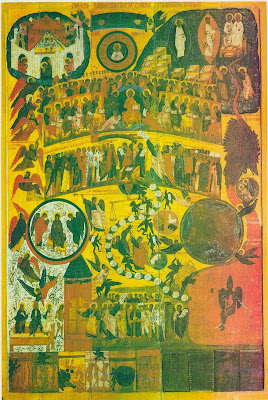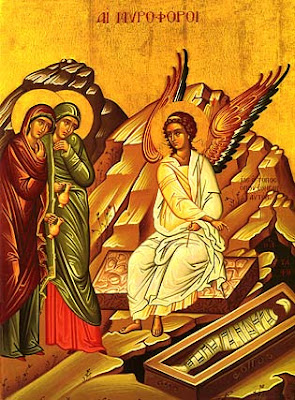 |
| St. James the Apostle, Brother of St. John the Theologian (Feast Day - April 30) |
Ruminating on words of piety.
On the thirtieth James was slaughtered with a murderous knife.
 |
| St. James the Apostle, Brother of St. John the Theologian (Feast Day - April 30) |
 |
| Sts. Jason and Sosipater (Feast Day - April 29) |
 |
| Relics of St. Barbara at the World Trade Center in New York City |
| Holy Nine Martyrs of Cyzicus (Feast Day - April 28) |
 |
| Russian icon of the Judgement depicting the toll-houses. This narration is included in the Synaxarion to be read by the faithful on April 28th. |
 |
| St. Symeon the Brother of God (Feast Day - April 27) |

 |
| Sts. Theocharis and Apostolos (Feast Day - Sunday of the Holy Myrrhbearers) |
 |
| St. George of Symvoulas |
 |
| St. Doukas the Tailor (Feast Day - April 24) |
 |
| St. Elizabeth the Wonderworker (Feast Day - April 24) |
 |
| St. Sava the Confessor (Feast Day - April 24) |
 |
| Russian Coat of Arms |
 |
| St. Glykerios the Farmer (Feast Day - April 23) |
Synaxarion of Saint George the Great Martyr and Trophy-Bearer
The Martyrdom of Saint George the Great Martyr
Saint George the Great Martyr: Epistle and Gospel Reading
Encomium to the Holy Great Martyr George the Trophy-Bearer (Theodotus of Ancyra)
6th-11th Century References to Saint George
Homily for the Feast of Saint George (St. Luke of Simferopol)
Homily on Saint George the Trophy-Bearer (Metr. Augoustinos Kantiotes)
Homily on the Holy Great Martyr George (Archimandrite George Kapsanis)
The Trophy-Bearer of Love (Elder Joseph of Vatopaidi)
Saint George the Trophy-Bearer as a Model for our Lives
A Vision of Saint George the Great Martyr In Glory
Why Saint George is Often Depicted Slaying a Dragon
Greek Epithets of Saint George the Great Martyr
Saint George: A Saint for the Desperate
Traditional Greek Songs to Saint George
The Veneration of Saint George in the Founding of the Russian State
Loutro Traianoupolis: Where Christians and Muslims Venerate Saint George
In Georgia, Everyday Is A Feast of Saint George
Saint George the Trophy-Bearer in Cyprus
Saint George and the Powers of Witches and Vampires
Saint George the Drunkard, Saint George the Poor, Saint George the Sower
Saints Associated With Saint George
Saints Gerontios and Polychronia, Parents of Saint George
Holy Martyrs Anatolios and Protoleon the Soldiers, Converted by Saint George
Holy Martyr Athanasios Who Was a Sorcerer, Converted by Saint George
Saint Alexandra the Empress of Rome, Wife of Emperor Diocletian
Saint Glykerios the Farmer of Nicomedia
Holy Martyr Nike
Holy Martyrs Victor, Zotikos, Zeno, Akindynos, Caesarios, Severian, Christopher, Theonas and Antoninos
Holy Eight Martyrs Eusebius, Neonos, Leontios, Longinus, Danabos, Demetrios, Nestabos and Christopher
Saint Nina of Georgia Resource Page
Saint Theodore the Sykeote, Bishop of Anastasiopolis
The Role of St. George in the Life of St. Theodore Sykeote
Saint Xenophon, Founder of the Athonite Monastery of Xenophontos
Saint George Appears to Saint Arsenios of Paros
Saint Phanourios Resource Page
Relics
The Translation of the Relics of Saint George to Lydda (St. Nikolai Velimirovich)
The Prison, Wheel, Torture Instruments and Chains of St. George in Cairo
Shrines
Synaxarion for the Dedication of the Temple of Saint George in Lydda
Report On St. George Church In Lydda
Oil and Myrrh Gushing from the Tomb of St. George in Lydda (video)
A Myrrh-Streaming Icon of Saint George in Israel
Report On the Church of St. George In Cairo
Commemoration of the Consecration of the Church of Saint George in Kyparission
Saint George, Protector of Zographou and Xenophontos Monasteries
The Cell of Saint George "The Revealed One"
The Wood Carved Statue of St. George in Kastoria
The Chapel of St. George on Lykavittos Hill in Athens
Chapel of Saint George at Mystras
The Milking of the Sheep in Honor of St. George in Crete
The Procession of the Icon of St. George With Horses
The Chapel of Saint George the Vampire in Thymari of Argolis
The Holy Monastery of Saint George and Panagia of Yellow Rock in Australia
The Church That Became Synonymous With Hell: A True Story of the Pontic Genocide
Miracles
An Encomium on the Miracles of Saint George the Great Martyr
3 Miracles of Saint George
Commemoration of the Miracle of the Great Martyr George in Zakynthos in 1688
When St. Arsenios of Cappadocia Was Rescued by St. George
What a Muslim Saw that a Faithful Christian Did Not
Miracles of St. George to Muslims at Koudouna
A Miracle of Saint George in 1940
A Miracle of Saint George the Trophy-bearer
The Great Miracle of Saint George of Symvoulas in 1992
An Icon of St. George is Gushing Myrrh in Cyprus
A Personal Testimony About the Myrrh-Gushing Icon of St. George in Cyprus
Another Icon of St. George Gushes Myrrh
A Greek Town is Speaking of a Miracle Following Discovery of a Skeleton
Miracle Reported in Russia Through the Relic of Saint George
"I Went to Christouli and Panagitsa High in Heaven": A Miracle of Sts. George and Raphael
The Story of How Saint George Led a Turkish Woman to be Baptized an Orthodox Christian
Saint Eumenios Saridakis, the Demon Possessed Girl and the Miraculous Icon of Saint George
 |
| St. Theodore of Sykeon (Feast Day - April 22) |
| St. Anastasios the Sinaite (Feast Day - April 21) |
 |
| St. Alexandra the Empress (Feast Day - April 21) |
 |
| St. Januarius and those with him (Feast Day - April 21) |
 |
| Holy Apostle Zacchaeus (Feast Day - April 20) |
 |
| St. John the Tailor of Ioannina (Feast Day - April 18 and Bright Tuesday) |
 |
| St. Makarios Notaras (Feast Day - April 17) |
 |
| St. Michael the Vourliotes (Feast Day - April 16) |
 |
| St. Irene of Greece (Feast Day - April 16) |
 |
| St. Leontios of Vlacherna (Feast Day - Bright Wednesday) |
 |
| Sts. Anastasia and Vasilissa of Rome (Feast Day - April 15) |
 |
| St. Savvas the Vimataris (Feast Day - Bright Tuesday) |
Holy Pascha Resource Page
BRIGHT MONDAY
Saints and Feasts of Bright Monday
BRIGHT TUESDAY
Saints and Feasts of Bright Tuesday
BRIGHT WEDNESDAY
Saints and Feasts of Bright Wednesday
BRIGHT THURSDAY
Saints and Feasts of Bright Thursday
BRIGHT FRIDAY
Saints and Feasts of Bright Friday
BRIGHT SATURDAY
Saints and Feasts of Bright Saturday
THOMAS SUNDAY
Thomas Sunday Resource Page
THOMAS MONDAY AND TUESDAY
Saints and Feasts of Thomas Monday and Tuesday
SUNDAY OF THE MYRRHBEARING WOMEN
Sunday of the Myrrhbearers Resource Page
SUNDAY OF THE PARALYTIC
Sunday of the Paralytic Resource Page
MID-PENTECOST
Mid-Pentecost Resource Page
SUNDAY OF THE SAMARITAN WOMAN
Sunday of the Samaritan Woman Resource Page
SUNDAY OF THE BLIND MAN
Sunday of the Blind Man Resource Page
APODOSIS OF PASCHA
Saints and Feasts for the Apodosis of Pascha
THE ASCENSION OF CHRIST
Ascension of Christ Resource Page
WEDNESDAY AFTER THE ASCENSION
SUNDAY OF THE HOLY FATHERS
Sunday of the Holy Fathers of the First Ecumenical Synod Resource Page
SEVENTH SATURDAY AFTER PASCHA
The Saturday of Souls Before Pentecost
The Significance of the Saturday of Souls Before Pentecost
Saturday of Souls Resource Page
PENTECOST
Pentecost Resource Page
MONDAY OF THE HOLY SPIRIT
Monday of the Holy Spirit Resource Page
SUNDAY OF ALL SAINTS
Sunday of All Saints Resource Page
A Meditation for the End of the Pentecostarion
SECOND SUNDAY AFTER PENTECOST
Second Sunday After Pentecost Resource Page
THIRD SUNDAY AFTER PENTECOST
Third Sunday After Pentecost Resource Page